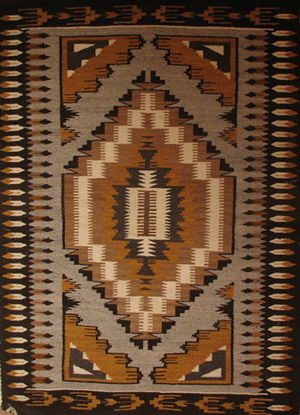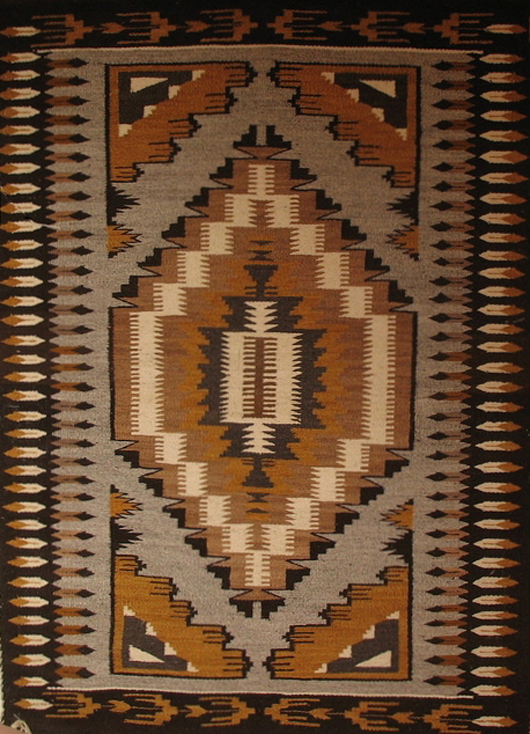
SANTA FE, N.M. (AP) – On the second Friday of every month, two very different groups of people, most of them New Mexicans, get together at a school on the Navajo reservation for one of the state’s most unique commercial customs.
The Crownpoint Rug Auction got started in 1968 as a way for Navajo weavers to profit more from their hand-spun and woven textiles that were once used casually as saddle blankets, but were quickly becoming expensive works of art.
By 4 p.m., when the doors open to the Crownpoint Elementary School, more than 100 Navajo weavers and their families begin moving into the gymnasium with the results of months of work rolled up in plastic containers.
They unroll their rugs at the registration desk, giving their names and hometowns, which are written onto small cards that are stapled to the rugs that are then displayed on four folding tables.
By 5 p.m., the bidders, almost all of them Anglos, begin to arrive and look through what will be for sale. The biggest contingency is from Albuquerque, with a few from Santa Fe, Rio Rancho, Farmington, Gallup, Las Cruces and other New Mexico towns, a handful from the contiguous states, a smattering from other states, and one European couple.
Some of the bidders look as if they are dripping with money. Most of them appear to know what they’re doing, taking notes and occasionally measuring the rugs. Sizes are not mentioned on the cards. A few bidders appear to be professional traders. They are the most discreet of all.
On Dec. 9, there were 227 rugs up for auction – ranging from 1-by-2-foot wall hangings selling for as little as $35 to rugs up to 8-by-4 feet that went for up to $1,500. About half of them failed to get a minimum bid. Fifty-five people signed up as bidders—slightly less than average, said to be about 75. The auction lasted about two hours.
Before the auction begins, there’s time for a Navajo taco and soda from a vendor inside the little school, and to look through more than a dozen tables with Native American crafts—Acoma pottery, Zuni fetishes, Navajo jewelry.
At 7 p.m., Christina Ellsworth, manager of the Crownpoint Rug Weavers Association, takes to the stage to welcome the bidders and weavers, and warn bidders against trying to buy the rugs outside in the parking lot. That would be unfair to the weavers who pay the association 15 percent of their selling price at auction, she said.
Then the auctioneers, Wayne Connell and Delbert Arty, take over. Mountainair residents who run cattle auctions in Belen, they begin with brief descriptions of each rug as young people display them to the audience. Then they begin their chant, “Do I hear eight hundred? Eight hundred, eight hundred. Eight hundred there! Do I hear nine hundred? Nine hundred, nine hundred … ”
If the rug fails to get a minimum bid after 30 seconds, the auctioneers declare it a no sale and direct it to be put in a special pile. Occasionally, the auctioneers drop the minimum price by $100 or so. In those cases, the rugs often draw a single bid from people seated quietly in the back—apparently professional traders seeking a discount.
In most cases, the rugs that do sell go for a third to half what they would be priced in a gallery in Santa Fe or other cities. Payments can be made in cash or personal check at a desk set up beside the auction stage, but no credit cards are accepted.
There are no overnight accommodations in Crownpoint, about three hours by car from Santa Fe. The nearest motels are in Thoreau on Interstate 40, with better lodging in Gallup or Grants. The next auction is Jan. 13.
Weavers Association manager Ellsworth said she has taken classes in rugmaking and is an amateur weaver herself. She said she’s not a professional, but is experienced enough to understand the amount of work that goes into shearing sheep, carding, dyeing and spinning wool into yarn, setting up a loom and weaving a rug with a unique pattern.
“I’ve done some weaving, but I don’t want to sell what I make,” she said. “It’s my rug, my design, and then I look at these rugs and I think, ‘How can they come up with these designs?’ You get these guys from Blue Gap, from Chinle, from Wide Ruins. How do they get these designs in their heads? I sit at my loom and I think, ‘What kind of design shall I make?’ It’s real puzzling.”
Ellsworth laughs at the prices paid for Navajo rugs off the reservation—“an arm and a leg”—versus what weavers get. She recalled how she and her mother stopped at a trading post near Farmington years ago to overhear a trader trying to persuade an elderly woman to sell him a big Ganado red at a low price.
“He just wanted to give her peanuts for it,” she said, “so my mom told her in Navajo, she said, ‘Don’t be selling your rug like that. You put a lot of work into it. Take it to the Crownpoint Rug Auction. You’ll get better money for it.’ So the lady got her rug and she left, and I felt like saying something to that man: ‘Why are you just giving them peanuts for those rugs? It’s a lot of hard work for them.’”
___
Information from: The Santa Fe New Mexican, http://www.sfnewmexican.com
Copyright 2012 Associated Press. All rights reserved. This material may not be published, broadcast, rewritten, or redistributed.
AP-WF-12-30-11 0703GMT
ADDITIONAL IMAGE OF NOTE



